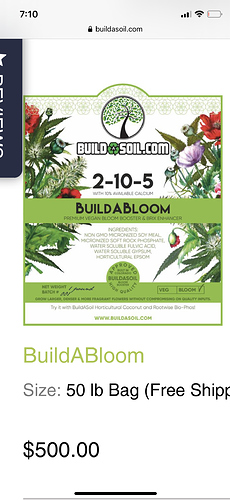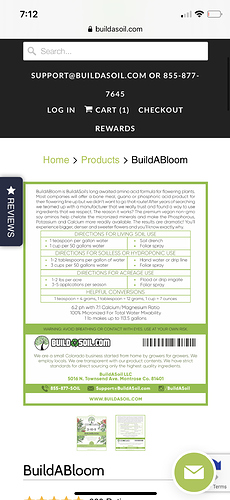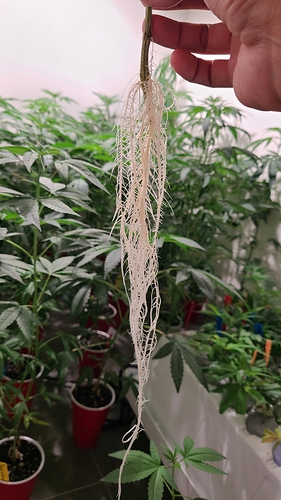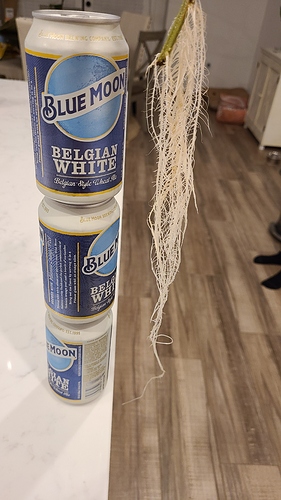What product from canna is made by this process?
That’s… Kind of a crock of shit. Mo is an essential micronutrient. If your plants live, they are getting at least some of it. Cobalt is also necessary in trace amounts but way worse for you. The other thing to note is that just because it’s not on the label, most of these nutrient mixes will have a bunch of micros. Including Mo and Ni
We spent a ton of time with a photometer testing various products, you’d be amazed the variance. Pretty much NPK is all you can count on being correct (ish). Phosphate forms in particular (MKP, MAP etc) come with a lot of extra stuff.
biocanna
Biocanna they literally have a special product formulated for every style of growing if you want to grow organic in soil , drain to waste in coco or rockwool , and recirculating hydro systems . I understand that trace minerals are required in "trace amount " that doesn’t mean that i want to feed it everytime i give grow and bloom i prefer to feed my trace minerals separately . This is just my opinion cannabis is a bio accumulator so i try to stay away from cheap input materials and heavy metals . For example i stay away from seabird guano because that is some nasty toxic shit not to say it doesn’t have tons of good microbes and NPK the negatives outweigh the positives for me
@SidViscous my main point is to be weary of trace elements in fertilizer because cannabis is a bio accumulator . Its easy to go over board and never be able to flush these things from your flower . Just because something is organic does not mean anything. In nature there are trace elements and heavy metals everywhere so this is why i only use the highest quality inputs . I have seen people reccomend blue cool aid growmore that is known for having arsenic . Please do not forget that if you are adding salt fertilizer to the ground water you are adding chemicals that can not be removed and destroying real living soil but hey fuck the environment were growing weed !
I mean I grow in rdwc and we reprocess almost all of our water so not really worried about it. I guess what I’m trying to point out is that those trace nutrients are definitely in the mixes you’re talking about. We use sodium molybdate directly in our media formulation but it works out to something like 400ppb. I doubt most of these green tax cannabis nutrient mixes are within even +/-200 ppb between batches. And the reality is that scavenger or not, there’s no way it’s going to add up enough to be a problem. You’d kill the plants with toxicity before that really became a concern with something like Zn or Mo. Which based on our research you may actually do if you follow Fox Farms feed charts (which I suppose is non sequitur)
Edit: units. Don’t use 400 ppm Mo, the plants will for sure die
The bio canna “Flores” is fire…
And omri
Made from beets, if my memory serves me correct. I will check next time I’m up at the grow.
Another really good product is buildabloom, from build a soil.
I just hate what modern AG is doing to the world with all the salt fertilizer and pesticides . Please do not take this as a stab against you personally. If you reuse all your water those salts have to still go somewhere weather its your plant or rinsed down the drain. The salts will still find their way into the environment some way they can not just disappear . Also Mo is specifically very toxic to the water table and fish and has a warning on most fertilizers with it because it is a requirement . The process of building real living soil is evolution it is the ultimate science . Nothing made in a lab can beat thousands of years of evolution . How do you deal with salt buildup and cleaning and how do you get rid of the aftermath ? I just wish people cared about the water table more . They are so many outdoor growers just pumping salt right into the ground killing everything . I work hard building the rhizosohere of my soil i do not want to kill it
What elements do you think they are breaking down in the fermentation?
It is a chelation process to make the organic nutrients bioavailable to the plant . In nature raw compost is not readily available in the form of nutrients to the plant . The compost is broken down by bacteria , fungus feeds on this , then single celled organisms feed on this , and finally earth worms and potatoes bugs break down the last bit . This entire process is how the plant is fed naturally . So during the fermentation process this process is replicated so the nutrients can become chelated and bioavailable to the plant this is for NPK and trace elements . A quick search of rhizosphere on google will explain these basics . This is why organic plants grow much deeper roots . When you use salt you have a plant on crack with short roots addicted to salt lol . This is what happens in big AG fields of cracked out salt plants with short roots in non living soil
Jadam: Organic Farming The way to Ultra-Low-Cost Agriculture by Youngsang Cho
I recommend buying it. I have, twice- one I gifted to a friend.
You guys ever wonder what preservatives are in general nutrients available on self. I mean they have to prevent it all from rotting. I mean except the charged salts based nutes.
I heard they use stabilizers and preservation chemicals to allow these nutrients especially some of the the quasi organic ones to last.
Blue moon for perspective about 5". So my salty roots come out of the cloner around 15". If I use Canna how long will they come out of the cloner, 30"? I also don’t grow in the ground(indoor and outdoor are in 100-200 gal SP) so my roots really only have so deep they can go. The difference here is I get 1.5g per watt using salts while the people you know have to spend some crazy
Look at you posting mini cans. Nice job love aero cloners.
I’m very familiar with dwc and know you can grow huge roots in buckets with salts . I was specifically talking about big monocrop farms growing with salts in soil(not cannabis) . When you feed salts in a huge field they do not grow deep they grow shallow because because the salts disturb the rhizosphere . Plant roots are insanely complex and when a plant is deficient it will send signals through the roots from healthy plants to the deficient ones of where this mineral or nutrient is causing the deficiency. This is what i was trying to explain about natural farming and roots growing very deep . When you monocrop on a large scale in a field ( big Agriculture ) this does not happen and the soil is dead . Moral of the story even if you use salts indoors you eventually have to put them back into the environment/ water table when you clean all the salt build up cleaning your grow equipment or pots ect getting rid of old rockwool or grow medium. I don’t know about you but i don’t like stuff being added to water that can never be removed and destroys everything it comes in contact with . Haha have you seen what algae bloom does to water its awful too . I know you can grow with salts that’s not the point. Its about the repercussions of going against nature and the havoc it will wreck on our life . If earthworms die they say we have 6 months to live … i could talk and talk its just my opinion permaculture is the true way not just mining all of the organic material from an area to use it in another .
calcium carbonate is way better for chelation.
also u can pump it all way through flower withiut adding niteogen…soil onlythough
also fulvic and humic acid work great for breaking down nutrients to make them bioavaible to the plant. break the chains down to somethinf the plant can take up and not over load sticking in ur soil
im against salt based for personal.
but for commerical salt based seems to be the cheapest and easiest to run
get ur rhizosphere right and it doesnt take much nutes at all doez it.
when i stopped geowing i was all about chelation and no salt based nutes
i had some the best around. my buddy growing same clones i would give himcoukdnever produce like me
maybe not the biggest yields but def the best quality the plant xould have
Using sun dried sea salt as part of your nutrient regimen is a game changer. Better than kelp and a fraction of the cost. Sea Energy Agriculture is a book by Maynard Murray on the subject and this can open your eyes to the miracles sea water can provide for the land. Dozens of trials where all kinds of pests and diseases present in control group crops literally ended at the row where the sea solids were applied. Studies on the marked improvement in flavor in fruits and vegetables grown with sea salt. And increases in Brix levels.
Minerals, enzymes, hydrogen, weak organic acids, fat, and macros. Plants basically love broths, lemonades, and teas.
You keep throwing rhizosphere around. Provide some studies that show salt fertilizers affect the microbiomes in the rhizosphere.
A lot of organic followers believe that the nutrients from organic sources are some how different from the ones provided by fertilizer. They are NOT! There is no lab in the world that can tell the difference between a nitrate molecule from manure and one from a bag of synthetic fertilizer. Plants can’t tell the difference either, because there is no difference. They don’t care where the nitrate came from.
A lot of people doubt science and in some advanced areas of investigation science may not be 100% correct. This is not one of these situations. All chemists agree on the above fact and have done so for a long time.
There have been many studies looking at the number of bacteria in soil after applying fertilizer. In Impact of Organic and Inorganic Fertilizers on Microbial Populations (ref 1), they looked at both bacteria and fungi populations, and compared untreated soil to (a) soil treated with organic material (manure, rock phosphate, neem cake) and (b) soil treated with synthetic fertilizer. Measurements were done at two different depths.
Adding synthetic fertilizer resulted in no change in the number of bacteria and an increase in the number of fungi. Organic treatment increased both fungi and bacteria slightly.



